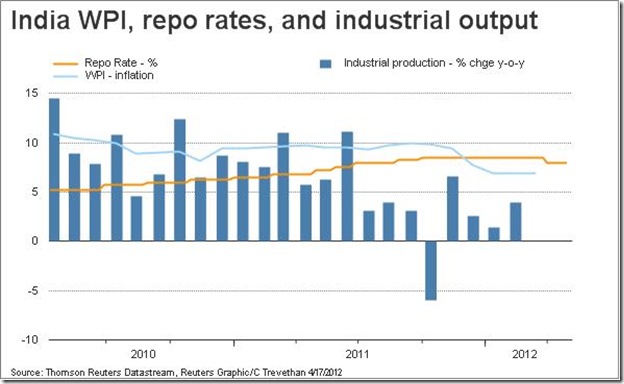In a move that pleasantly surprised the market, RBI’s governor announced a 50 bps (0.5%) cut in the repo and reverse repo rates, while keeping the CRR unchanged. The consensus estimate, after announcement of a slightly lower WPI inflation rate on Monday (Apr 16 ‘12), was a 25 bps cut. The repo and reverse repo rates are back to levels last seen in Jul ‘11.
RBI had made it quite clear through several previous policy announcements and interest rate hikes that controlling inflation was its top priority, even if it curtailed growth. Of late, it had come under a lot of criticism from corporate bigwigs and analysts for being too hawkish, since the rate hikes didn’t help in bringing down inflation by much.
Monetary policy alone can not help moderate inflation in a situation where the country’s current account deficit (currently at 4.3% of GDP) and government’s fiscal deficit (now at 5.9% of GDP) are at unsustainable levels. RBI had pretty much exhausted its policy options. Unless the finance ministry reduced its wasteful expenditure on subsidies and took bold decisions on economic reforms, there wasn’t much the RBI could do. Note the status quo that existed from Nov ‘11 to Mar ‘12 in the chart below:
Q3 GDP figure of 6.1% – down from the heady days of 9-10% growth a few years back – and WPI inflation falling below 7% probably forced the RBI’s hand. They were being made the scapegoat for India’s sliding GDP growth, when the blame should have been laid squarely on an inept and scam-ridden government.
Today’s 50 bps rate cut is a clear message to the finance ministry from the RBI: “We have done more than was expected; now it is your turn.” Unless efforts are made to curtail deficits and bold policy initiatives are taken to attract overseas investments, inflation will start rising again as the base effect of the previous year wears off. The RBI governor has clearly mentioned the possibility in his policy statement. Further rate cuts that are required to stimulate the economy and incentivize capital expenditure by corporate India will then be kept on hold.
The following chart depicts the relation between the repo rate, WPI inflation and industrial production over the past eight quarters:
It is quite clear from the chart that industrial growth has been affected in a high interest regime. Will corporate India jump up and open its purse strings because of the 0.5% lowering of interest rate? Not very likely. That means slow growth will continue for another quarter or two. It is now up to the government to take policy decisions that will be good economics rather than good politics.
The proposed ban on prepayment penalty of floating rate loans will be welcomed by EMI payers. For the stock market, any drop in interest rate is good news. The bulls should come charging with renewed vigour.
Related Posts


No comments:
Post a Comment